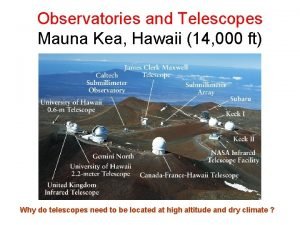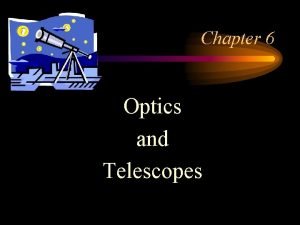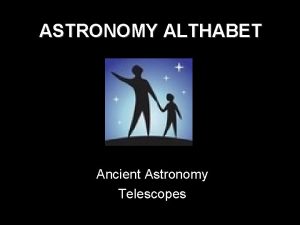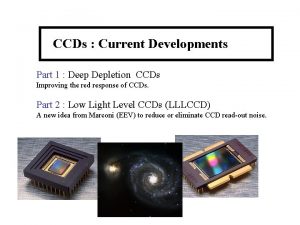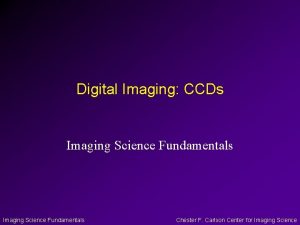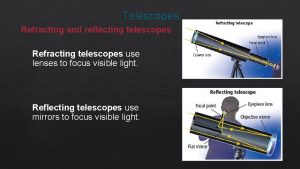Optical Astronomy Imaging Chain Telescopes CCDs Reflector telescopes










- Slides: 10

Optical Astronomy Imaging Chain: Telescopes & CCDs

Reflector telescopes: basic principles • reflection: angle in = angle out – as a result, spherical mirrors would suffer from spherical aberration • the virtues of parabolas – parallel incident rays are brought to common focus – => primary mirrors are ground to paraboloid shape

Optical Reflecting Telescopes • Basic optical designs: – Prime focus: light is brought to focus by primary mirror, without further deflection – Newtonian: use flat, diagonal secondary mirror to deflect light out side of tube – Cassegrain: use convex secondary mirror to reflect light back through hole in primary – Nasmyth focus: use tertiary mirror to redirect light to external instruments

Telescope f-ratio • f = F/D where F is focal length and D is diameter – must consider focal length of primary & secondary mirrors combined • Determines “plate scale” – plate scale is measured in e. g. arcsec per mm at the focal plane – can be estimated from our friend, the small-angle relation theta=S/F • plate scale = theta/S = 1/f. D • for an f/16 10” telescope, plate scale = 50 arcsec per mm

CCDs: pixel scale and field of view • Example: CCD pixel scale – take a plate scale of 50 arcsec per mm – CCD pixels are about 25 microns – => pixel scale would be 1. 25 arcsec per pixel • Example: CCD field of view – For a 1000 x 1000 CCD with 1. 25 arcsec pixels, field of view is 1250” or about 21 arcmin (could image most of Moon’s surface)

CCDs: pixel scale and field of view • Want to match CCD pixel scale to image “smear” = point spread function – remember main sources of image smear • telescope angular resolution • atmosphere – ideally, arrange pixel scale such that 2 CCD pixels cover width of PSF • image field of view then limited by format (number of pixels) of CCD – the bigger the better, but bigger means more expensive

CCDs: noise sources • dark current – can be “removed” by subtracting image obtained without exposing CCD • leave CCD covered: dark frame • read noise – detector electronics subject to uncertainty in reading out the number of electrons in each pixel • photon counting – Poisson statistics: if I detect N photons, the uncertainty in my photon count is root(N)

CCDs: artifacts and defects • bad pixels – dead, hot, flickering… – methods for correcting: • replace bad pixel with average value of the pixel’s neighbors • dithering telescope: take a series of images, move telescope slightly to ensure image falls on good pixels • pixel-to-pixel differences in QE – can construct and divide images by the flat field • flat field is what CCD would detect if uniformly illuminated • saturation – each pixel can only hold so much charge (limited well depth) – at saturation, pixel stops detecting new photons (like overexposure) • charge loss occurs during pixel charge transfer & readout

Spectral Response (sensitivity) of a typical CCD UV Visible Light IR Relative Response 300 400 500 600 700 800 900 1000 Incident Wavelength [nm] • Response is large in visible region, falls off for ultraviolet (UV) and infrared (IR)

Filters • Because CCDs have broad spectral response, need to use filters to determine e. g. star colors in visible • broad-band: filter width is about 10% of filter’s central wavelength – example: V filter at 550 nm will allow light from 500 to 600 nm to pass through – astronomers use BVRI: blue, ‘visible’, red, IR • narrow-band: filter width is <1% – example: “H-alpha” covers 650 to 660 nm
 Chromatic aberration affects reflector telescopes.
Chromatic aberration affects reflector telescopes. All modern large optical telescopes are refractors.
All modern large optical telescopes are refractors. Frc control system
Frc control system Learning astronomy by doing astronomy activity 1 answers
Learning astronomy by doing astronomy activity 1 answers Learning astronomy by doing astronomy answers
Learning astronomy by doing astronomy answers Learning astronomy by doing astronomy
Learning astronomy by doing astronomy Optical imaging
Optical imaging Grazing food chain diagram
Grazing food chain diagram Reflector big five
Reflector big five Umdf reflector
Umdf reflector What is the big five personality test
What is the big five personality test
